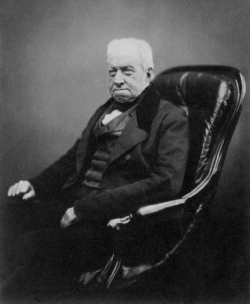Robert Brown

- Born
- 21 December 1773
- Died
- 10 July 1858 (age 84)
Robert Brown was a Scottish botanist who played a huge role in improving plant taxonomy. Among many scientific achievements, he gave the cell nucleus its name, discovered the phenomenon now called ‘Brownian motion’, and was the first to record much of Australia’s flora.
Brown began his scientific career studying medicine in the Universities of Aberdeen and Edinburgh. However, a visit to London brought him to the attention of Sir Joseph Banks, a botanist who first swayed Brown’s career towards botany. Banks recommended Brown for a post as a naturalist on board a ship heading to Australia on a surveying voyage, which Brown accepted.
The ship sailed out in July 1801 and finally reached the western banks of Australia five months later. The area where they landed was high in floral biodiversity and much of it was new to science. For the following 18 months Brown collected specimens of the plants and classified a staggering 3,900 species. This was a huge contribution to science and plant taxonomy. Brown had a strong work ethic and made critical investigations with ‘painstaking detail’, much of it done with the aid of a microscope.
After returning to England in 1805 Brown published his findings. His analysis and study of plants were extremely thorough and he made the fundamental distinction between gymnosperms (non-flowering plants like conifers) and angiosperms (flowering plants). These two groups have a differing evolutionary history, with gymnosperms being the first to evolve and angiosperms evolving much later. Brown’s studies showed how different the reproductive processes of these two classes of plants are. Because flowering is a more advantageous reproductive method than producing cones, angiosperms now represent about 80% of green plants.
He seemed to me to be chiefly remarkable for the minuteness of his observations and their perfect accuracy. He never propounded to me any large scientific views in biology. His knowledge was extraordinarily great, and much died with him, owing to his excessive fear of never making a mistake. He poured out his knowledge to me in the most unreserved manner, yet was strangely jealous on some points.
Charles Darwin, Autobiography of Charles Darwin, 1958
In honour for having first observed it, Brown also lends his name to the widely known scientific phenomenon of Brownian motion. The motion describes the random movement of microscopic particles when they are suspended in liquid or gas. Brown first discovered this when he was looking at the pollen grains of a flowering plant, Clarkia pulchella, under a microscope. He observed a ‘rapid oscillating motion’ of the pollen particles and published his study in a pamphlet in 1828.
Another large contribution of Brown’s was the naming of the ‘nucleus’ in 1831. He was investigating the cells of orchids and noticed the existence of a structure within the cells, which he realised, occurred in many other plants too. Although this wasn’t the first time that the structure was observed, Brown was the first to designate it its name.
Brown was elected a fellow of the esteemed Royal Society in 1810 and served as president of the Linnean Society from 1849 to 1853. A number of Australian plant species, including Brown’s banksia (Banksia brownii) and Brown’s box (Eucalyptus brownii), are named after him. Brown passed away in 1858 in London.



